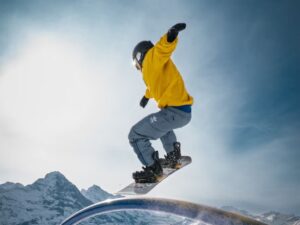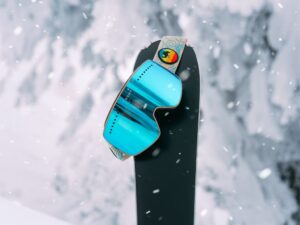With its exhilarating descents and gravity-defying tricks, snowboarding is a mesmerizing sport. Especially when you’re on top of the mountain, and the little rays of sunshine hit the snow at just the right angles.
That said, not everything about snowboarding is hunky dory. One of most boarders’ biggest worries is if snowboarding is bad for your knees.
The fast-paced descents, sharp turns, and high-impact landings can stress the knees, raising questions about the long-term effects. However, it’s important to remember that you can minimize whatever impact with proper techniques, precautions, and conditioning.
The knee joint is a complex network of bones, ligaments, tendons, and cartilage that work together. Ligaments like the ACL and MCL offer support, while tendons connect muscles to bones. Cartilage, like the menisci, cushions the knee joint, which absorbs shocks during movements.
According to the research, snowboarders most common knee injuries among snowboarders are torn ligaments, especially the anterior cruciate (ACL) and medial collateral ligament (MCL). These injuries are often a result of incorrect jumps and posture while riding the board.
Whether you’re a seasoned snowboarder or considering the sport, understanding the impact on knee health is essential for a safe and enjoyable experience on the slopes. Let’s get to it.
Disclaimer: I’m not your doctor. And this guide isn’t meant to replace a healthcare professional’s advice. This guide is purely informational to help you safeguard yourself against unprompted injuries.
Most Common Knee Injuries in Snowboarding
Snowboarding, like any active sport, carries the risk of knee injuries. By being aware of these injuries, you can take proactive measures to prevent them and ensure the longevity of your knee health.
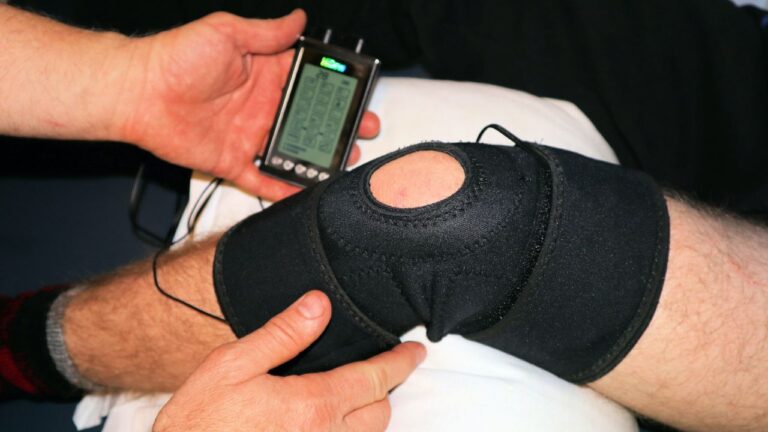
1. ACL Tears
The anterior cruciate ligament (ACL) is one of the major ligaments in the knee that helps stabilize the joint. Snowboarding maneuvers involving sudden stops, direction changes, or awkward landings can significantly stress the ACL.
The twisting and rotational forces exerted on the knee during these movements can lead to ACL tears, causing pain, instability, and potential long-term complications.
2. MCL Sprains
The medial collateral ligament (MCL) runs along the inner side of the knee, providing stability and preventing excessive sideways movement.
In snowboarding, MCL sprains often occur when the knee is subjected to a forceful blow or a sudden change in direction. These injuries can result in pain, swelling, and difficulty with weight-bearing.
3. Meniscus Tears
The menisci are C-shaped pieces of cartilage that act as shock absorbers within the knee joint. Snowboarding maneuvers involving deep knee flexion, excessive twisting, or forceful landings can strain the menisci.
4. Patellar Dislocation/Subluxation
The patella (kneecap) can become dislocated or partially dislocated (subluxated) when the knee experiences a sudden, forceful impact or twisting motion.
Snowboarding jumps and landings, especially if improperly executed, can increase the risk of patellar dislocation. Symptoms include severe pain, swelling, and an inability to straighten the knee.
5. Patellar Tendinitis
Also known as jumper’s knee, patellar tendinitis is an overuse injury that affects the patellar tendon. Repetitive jumping, landing, and quick directional changes in snowboarding can strain the patellar tendon, leading to inflammation, pain, and tenderness below the kneecap.
How does snowboarding affect your knee?
Snowboarding undoubtedly puts considerable stress on the knees since they’re involved in almost every movement.
1. Forces and Stresses: The abrupt stops, quick turns, and high-impact landings exert significant pressure on the knee joints. Additionally, repetitive flexing and extending the knees can contribute to wear and tear over time.
2. Knee Alignment: Incorrect posture and technique can lead to abnormal stress on specific knee areas, potentially increasing the risk of injuries.
3. Impact of Maneuvers: Jumps, especially from significant heights or executed with improper technique, can expose the knees to excessive force upon landing. Similarly, quick turns and twists during tricks or freestyle riding can strain the ligaments and cartilage of the knee joint.
4. Terrain and Conditions: Riding on uneven surfaces, moguls, or hard-packed snow can increase the risk of sudden jolts or unexpected knee impacts.
It’s important to note that while snowboarding can pose challenges to knee health, proper technique, conditioning, and preventative measures can significantly reduce the impact.
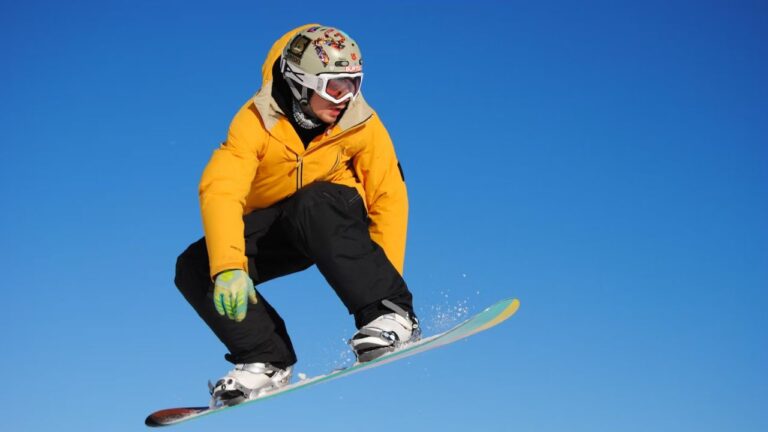
How to prevent knee injuries in snowboarding?
To ensure optimal knee health while enjoying the exhilaration of snowboarding, it’s important to take proactive measures to prevent injuries.
1. Warm-Up and Stretching
Before hitting the slopes, it’s crucial to warm up your muscles and prepare your body for the physical demands of snowboarding.
Engaging in dynamic stretches, such as leg swings, lunges, and hip rotations, helps increase blood flow, improve flexibility, and reduce the risk of muscle strains.
2. Proper Technique and Body Mechanics
Maintaining a balanced stance, bending your knees slightly, and using controlled movements can help distribute forces evenly and minimize the risk of injury. Seek instruction from certified snowboarding instructors to ensure you develop good habits from the start.
3. Appropriate Equipment
Using well-fitted snowboarding equipment is essential for protecting your knees. Ensure your boots provide adequate support and are properly fit to maintain stability. Bindings should be adjusted correctly to allow efficient power transfer and minimize knee stress.
4. Strengthening Exercises
Incorporating strength and conditioning exercises into your fitness routine can enhance knee stability and resilience.
Focus on exercises that target the muscles surrounding the knees, such as the quadriceps, hamstrings, and glutes. Squats, lunges, step-ups, and leg presses can help build strength and stability in the lower body.
5. Cross-Training
Other exercises and physical activities can complement your snowboarding performance and improve your knee health. Cycling, swimming, and yoga can improve strength, flexibility, and joint stability. This cross-training approach helps prevent muscle imbalances and enhances your body’s ability to withstand snowboarding demands.
6. Rest and Recovery
Listen to your body and give yourself time to recover between snowboarding sessions. Fatigue can compromise your technique and increase the risk of accidents and injuries. Incorporate rest days into your schedule and prioritize quality sleep for optimal recovery.
Remember, injury prevention is key to maintaining knee health in snowboarding. By implementing these preventative measures, you can minimize the risk of knee injuries, enhance your performance, and make the fun last longer!
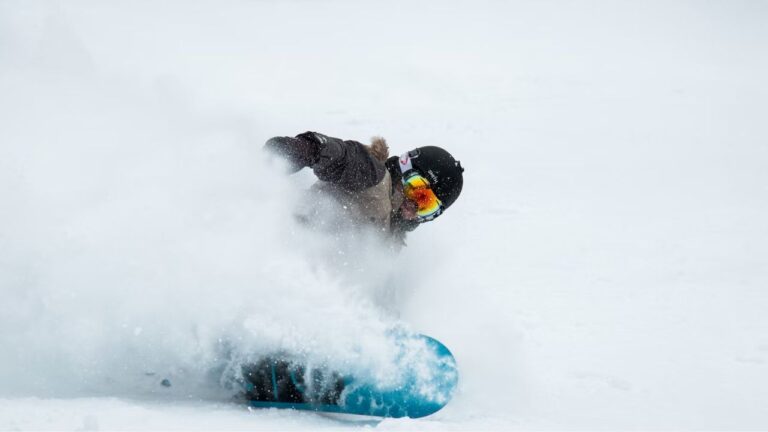
Tips for Injury Recovery and Rehabilitation
If you’ve experienced a knee injury while snowboarding, the road to recovery and rehabilitation is essential for returning safely to the slopes. Here are some valuable tips to guide you through the process:
1. Seek Professional Guidance: Consult an orthopedic specialist or a sports medicine professional who can accurately diagnose your injury and provide a tailored treatment plan.
2. R.I.C.E. Method: Rest, Ice, Compression, and Elevation. Rest the injured knee, apply ice packs to reduce swelling, use compression bandages to support the joint, and keep your leg elevated to reduce inflammation. Following the R.I.C.E. method in the early stages can help manage pain and aid healing.
3. Physical Therapy: A qualified physical therapist can design a personalized rehabilitation program based on your injury and specific needs. This program typically includes exercises to improve the range of motion, strengthen the muscles around the knee, and enhance stability.
4. Gradual Return to Activity: Rushing back into intense snowboarding activities can risk reinjury and hinder recovery. Start with low-impact exercises and activities that don’t strain the knee joint, such as gentle walking or stationary cycling.
5. Listen to Your Body: Pay attention to any pain, discomfort, or swelling during or after activity. If you experience increased pain or reinjury signs, consult your healthcare provider immediately. Pushing through pain or ignoring warning signs can lead to further damage and prolong your recovery.
6. Protect Your Knees: Use braces or supports for stability and protection. Ensure your equipment, such as bindings and boots, is properly adjusted and fitted to avoid unnecessary knee strain.
What is better for your knees, skiing or snowboarding?
The debate between skiing and snowboarding has been ongoing for years, and many enthusiasts wonder which sport is better for their knee health.
In general, skiing is better for your knees than snowboarding. Skiing uses a parallel stance with each foot on a separate ski, which allows for independent and natural leg movement. In comparison, the sideways stance in snowboarding places more strain on the knees.
The asymmetrical nature of snowboarding can put additional stress on the front knee, particularly for riders who predominantly make turns in one direction. However, proper technique, body alignment, and conditioning can help minimize knee strain while snowboarding.
Whether you choose skiing or snowboarding, always prioritize safety, maintain good technique, listen to your body, and consult with healthcare professionals for any concerns regarding knee health.
Enjoy the slopes while taking care of your knees!
Expert QnA
Q. Is snowboarding inherently bad for your knees?
Snowboarding itself is okay for your knees. However, certain factors and techniques involved in snowboarding can increase the risk of knee injuries if not properly addressed.
Q. Can proper technique and body mechanics reduce the risk of knee injuries in snowboarding?
Proper snowboarding techniques and maintaining good body mechanics can significantly reduce the risk of knee injuries. Maintaining a balanced stance, using proper alignment and control, and avoiding excessive twisting or bending motions that can strain the knee joints are essential.
Q. Should I wear a knee brace while snowboarding?
Using knee braces is a personal choice and depends on individual circumstances. While knee braces can provide some support and stability, they aren’t guaranteed against injuries. If you have a history of knee issues or are recovering from a knee injury, consult a medical professional.
Q. When can I return to snowboarding after a knee injury?
The timeline for returning to snowboarding after a knee injury varies depending on the severity of the injury and individual healing factors. It’s crucial to follow the guidance and recommendations of your medical professional or physical therapist. Returning too soon can exacerbate the injury or delay the healing process.


